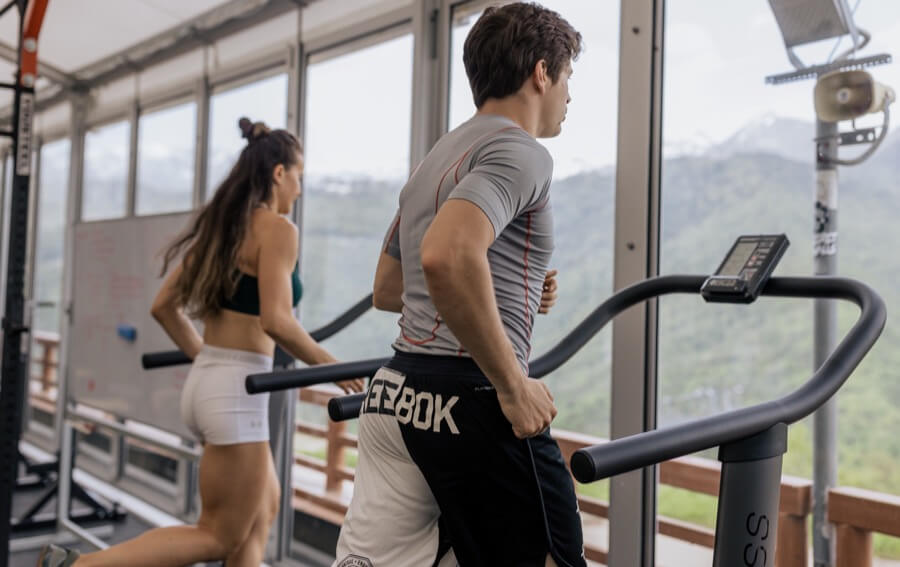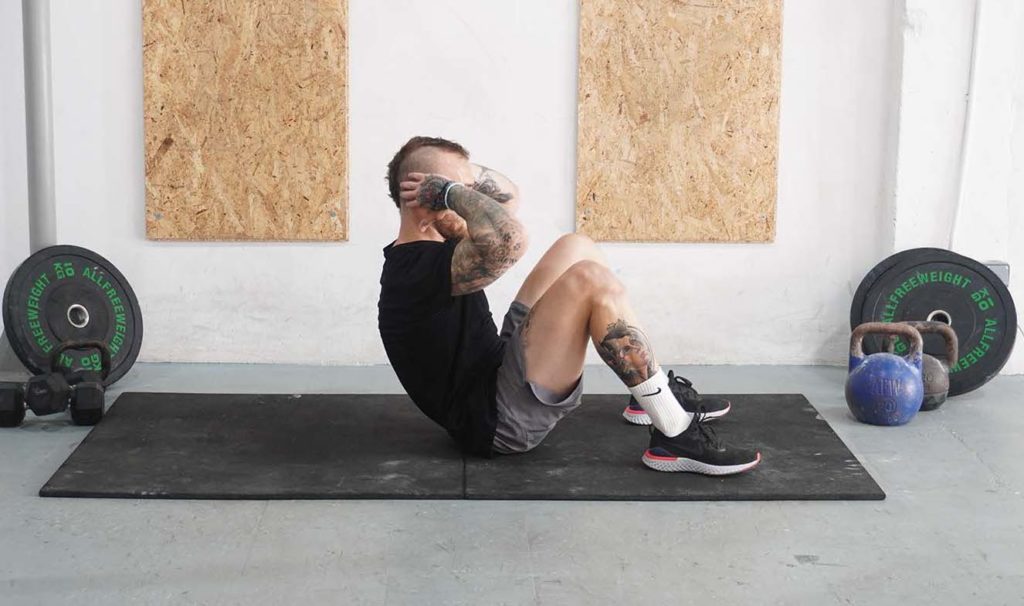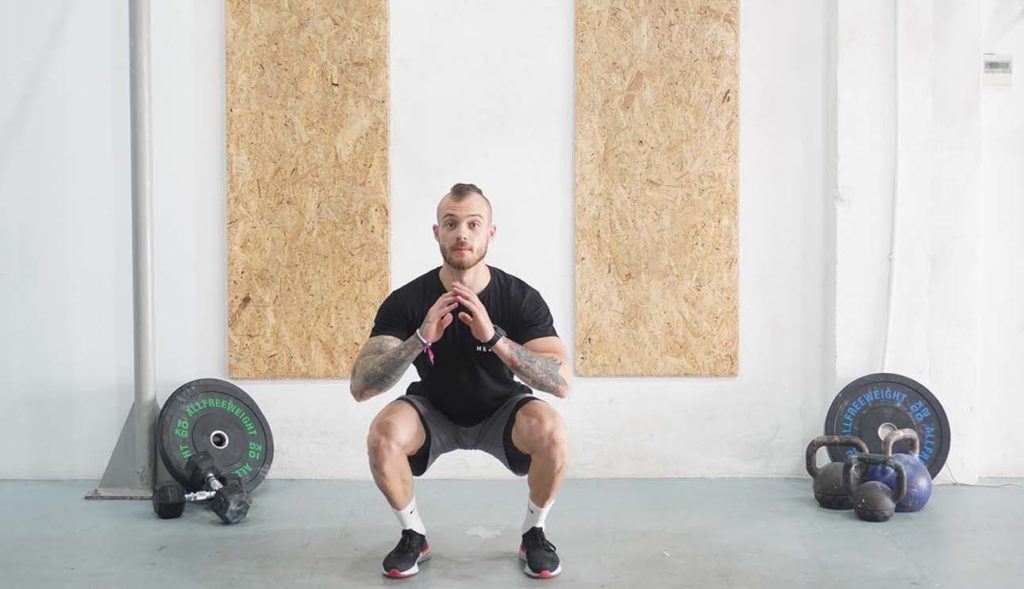Saitama, also known as One Punch Man, is a badass who can defeat even the most dangerous opponents with a single punch, hence his nickname. In case you’re wondering why you’ve never seen him in an MMA or boxing listing, it’s because he’s a fictional character.
What began as a joke slowly transformed into a beloved manga with fans worldwide. In this fictional story, Saitama struggles with a problem: he’s too strong. Because of his immeasurable strength, Saitama often defeats opponents with a single punch and struggles to find a worthy challenger. In other words, he usually gets bored.
What Is The One Punch Man/Saitama Workout?
A few years after the manga series began, Saitama shared the training routine that has turned him into the all-powerful One Punch Man. No, it’s not your traditional upper/lower or push/pull/legs split. Instead, the One Punch Man workout consists of:
- 100 squats
- 100 push-ups
- 100 sit-ups
- 10 km/ 6.2 miles run
These four exercises would be done every day for an extended period. The One Punch Man challenge is simply a dedicated effort to work up to the workout routine and do it every day for a while. It could be a week, a month, or longer. However, I can’t help but wonder if he didn’t sneak a few sets of dumbbell rows without telling anyone. But is this routine effective in the real world, or is it best reserved for fictional characters? Let’s discuss.
What are the Benefits of One Punch Man Workout?
Though simple, the One Punch Man workout offers some fantastic benefits for us:
- Building up your chest, tricep, and shoulder muscles and pushing strength (2)
- Strengthening your legs and building up your quadriceps (1)
- Strengthening your abs and developing superior core stability (3)
Plus, running has its unique benefits to consider:
- Improves your endurance and work capacity (4)
- Lowers your resting heart rate and blood pressure (5)
- Lowers blood glucose and triglyceride levels
- Boosts your mood and melts stress

On top of that, this workout is simple and requires no equipment. Meaning you can do it as is, regardless of where you are. It’s also a great way to start the day.
Is the One Punch Man an Effective Workout?
The One Punch Man workout can be effective, but everyone interested needs to approach it with realistic expectations. One Punch Man is a fictional character who struggles with something none of us are familiar with: being too strong. You cannot expect the workout routine to deliver the same results as it does for Saitama because real progress takes time. Try tracking your workouts with Hevy to stay consistent.

Hevy – Workout Tracker





Hevy – Workout Tracker
Create your own one punch man workout with Hevy, and track your progress – for free
It’s also important to note that you’re doing a lot of repetitions each day. You must track your performance and look for signs of overtraining. People new to the routine are more likely to experience significant soreness initially, which can impact their ability to stay consistent with the routine.
Another thing to consider for the One Punch Man workout is that it might not deliver an adequate stimulus to all major muscles because you’re only doing squats, push-ups, sit-ups, and running. These activities are beneficial, but basing your entire training plan on these four movements alone could lead to muscle imbalances.
As far as exercise selection goes, many people consider sit-ups an ineffective core exercise. Trainees often perform the exercise incorrectly, failing to train their abs well and only putting unnecessary stress on the spine. There might be better movements trainees can use to strengthen their midsection without doing as many reps each day.
Still, there are plenty of case studies of folks who’ve done the workout for a while and made significant progress, but it would be best to pair the One Punch Man workout with something else for more balanced development.
What to be Cautious of with the One Punch Man?
You should be cautious of the training stress this routine puts on your body. It’s best to start small and gradually do more work to give your body enough time to get used to it. The One-Punch Man workout also doesn’t feature any rest days, which can be a huge problem. Regardless of how fit you are, rest days are essential, and you should incorporate at least one to two into your training weeks.
Saitama’s workout also falls short because it can’t train your entire body in a balanced way. Sure, squats, push-ups, and sit-ups are great. But only doing these three movements prevents you from giving your back, shoulders, biceps, glutes, and hamstrings enough work, which can lead to muscle imbalances. Finally, it’s also worth noting that doing such high volumes of the same exercises every day can lead to overuse injuries. The reason is that you’re stressing your joints, muscles, and connective tissues in the same way, which can worsen their integrity over time.
How to Progress Up to the Full One Punch Man Workout?
Some training programs – such as the 5×5 and full-body workout – are simple to start. You can begin with weights you can manage and gradually work your way up. In contrast, Saitama’s workout is more challenging to understand because you can’t adjust the difficulty quickly.
Depending on your fitness level, doing 100 squats, push-ups, and sit-ups can be difficult, so you need to work up gradually. But how do you do that? Well, repetition-based progression is simple and works great. For example, begin with ten push-ups, squats, and sit-ups along with a kilometer (0.62 miles) of running per day. Gradually scale it up over the weeks:
Week 2: 15 squats, push-ups, and sit-ups + 1.5 km run (0.93 miles)
Week 3: 20 squats, push-ups, and sit-ups + 2 km run (1.24 miles)
Week 4: 25 squats, push-ups, and sit-ups + 2.5 km run (1.55 miles)
And so on.
It will take you a while to work up to the entire workout, but this progression scheme will be more sustainable in the long run. You won’t place too much stress on your joints and tissues right from the start. Instead, your body will have time to adjust to the physical stress. Too many people start strong and give up because they overtrain or injure themselves. Plus, it’s one thing to be able to do this workout once. But it’s a whole other thing to do it daily. Even if you feel fine initially, you might start feeling overtrained after a few days of doing it. You can track your progress into the full One Punch Man workout with the Hevy workout tracker.





Hevy – Workout Tracker





Hevy – Workout Tracker
Create your own one punch man workout with Hevy, and track your progress – for free
Exercises in the One Punch Man Workout
The One Punch Man routine is as straightforward as it gets:
- Squats – great for building leg strength and mass (1)
- Push-ups – fantastic for chest, tricep, and shoulder growth (2)
- Sit-ups – helpful in training the rectus abdominis and improving overall core strength (3)
Besides that, you also have running, which is excellent for maintaining normal body weight, increasing endurance, and improving your work capacity (4).
Exercise 1: Sit-Ups
Sit-ups are a simple and effective exercise for strengthening your rectus abdominis without needing any special equipment.


Muscle groups: Rectus Abdominis and Transverse Abdominis
Equipment: Exercise Mat
Step by Step Instructions:
- Lie on the floor, bend your knees, and place your feet flat on the floor.
- Put the tips of your fingers on the back of your head.
- Take a breath and engage your abs.
- Raise your torso off the floor by crunching your abs. Don’t think of it as an up and down motion. Instead, imagine that you’re trying to fold your torso by bringing your chest into your lower abs.
- Go up until your torso is almost upright and hold the position for a moment. Exhale.
- Lower your upper body to the floor, making sure to control the movement with your abs.
Exercise 2: Push-Ups
Push-ups are one of the most effective bodyweight exercises you can do to develop overall pressing power and build up your pectorals, shoulders, and triceps.


Muscle groups: Chest, Shoulders, Triceps, Serratus Anterior, and Abs
Equipment: none
Step by Step Instructions:
- Get down on all fours. Your wrists, elbows, and shoulders should be in a straight line.
- Extend your legs, so your ankles, knees, hips, and shoulders are also in a straight line.
- Engage your abs, bring your shoulders back, and squeeze your glutes.
- Make sure your fingers point forward and slightly out – this will put your elbows and shoulders in a good position as you lower yourself.
- Take a breath and lower yourself by bending at the elbows.
- Descend as much as you can – ideally until your face almost touches the floor.
- Press up, fully extending your elbows, and exhale near the top.
Exercise 3: Squats
Similar to push-ups, the squat is a fantastic bodyweight exercise that builds your entire lower body.


Muscle groups: Quadriceps, Glutes, Hamstrings, Calves, and Abs
Equipment: none
Step by Step Instructions:
- Stand tall and spread your feet slightly wider than hip level. Point your toes slightly out.
- Bring your shoulders back, engage your abs, and raise your hands forward for balance.
- Take a breath and squat while keeping your heels in contact with the floor.
- Go down as much as your mobility allows – ideally until your thighs become parallel to the floor.
- Press through your heels and go back to the top, exhaling on your way up.
Final Thoughts on the One Punch Man
Saitama is a badass with a fantastic right hook. His One Punch Man workout is also decent and delivers many benefits. For example, this routine is great for building strength in several key places of your body. The routine is also great for losing weight, improving your cardiovascular health, and becoming more resilient.
The One Punch Man workout also carries several drawbacks, which we can’t overlook. Most notably, the routine prevents you from giving enough attention to all the major muscle groups in your body. For example, your back doesn’t get any attention. Due to its repetitiveness, the workout routine also increases the risk of an overuse injury. Running, squatting, and doing push-ups are all great. But doing these activities daily can have its toll on your joints and connective tissues.
If you’re interested in trying the routine out, combine it with other types of training that allow you to train more muscle groups and vary the stress you’re placing on your body. For example, you can follow a 5-day split where some of your workouts consist of running, push-ups, sit-ups, and squats. The rest could focus on other muscle groups like your back and glutes.










